Casey Reynolds, PhD
Tropical Sod Webworm: Herpetogramma phaeopteralis
Description
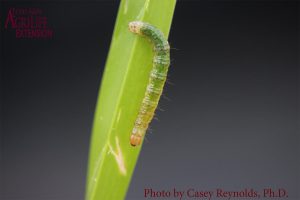
Tropical sod webworms (Figure 1) belong to the insect order Lepidoptera and family Pyralidae. The larval stage of this pest can cause significant damage to managed turfgrasses in a short amount of time, often over a period of just a few days. They can be pests in all warm-season turfgrasses in the southern United States, but in Texas they feed primarily on lawn grasses such as St. Augustinegrass (Stenotaphrum secundatum (Walt.) Kuntze) and have also been observed on bermudagrass (Cynodon spp.) golf courses.
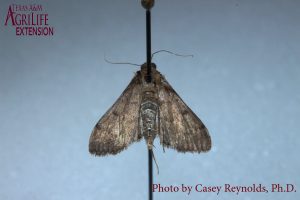
Like other caterpillar pests of turfgrasses, including fall armyworms and cutworms, the tropical sod webworm develops through complete metamorphosis and has the following stages: eggs, larvae, pupae, and adults. Tropical sod webworm adults (Figure 2) are brown moths with a mature wingspan of approximately 20 mm (3/4 inch). The wings form a triangular shape when resting. They are susceptible to cold and do not survive severe winters, thus limiting their most severe damage to south Texas where winters are mild. Tropical sod webworms overwinter as larvae, but adults have been documented throughout the year in other southern states, such as Florida. Adult moths spend the day in and around lawns and when disturbed by human activity will make brief flights before coming to rest in other areas. After mating, adult moths lay clusters of eggs on turfgrass blades or other moist surfaces.
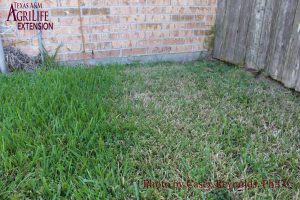
After the eggs hatch, larvae begin feeding on turfgrass leaves, primarily at night or on overcast days. As these larvae feed and begin to prepare their cocoon for pupation, they web together small pieces of grass, feces, and other debris–thus giving them the name “sod webworm”. In turfgrass areas that are mowed below 1 inch, such as golf course fairways or putting greens, webbing from the larvae is visible to the naked eye and can be useful for identifying this pest. The fact that sod webworm larvae feed primarily at night makes scouting for larvae during the daytime hours particularly difficult. However, symptoms of tropical sod webworm damage are often easy to identify in heavily infested areas. The height of the turfgrass in affected areas will
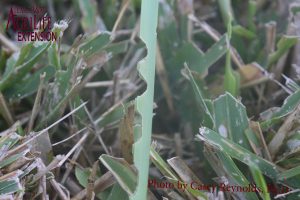
often be significantly shorter than un-affected areas (Figure 3) and turfgrass leaf blades may have a notched appearance as a result of chewing by the larvae (Figure 4). This injury can occur very quickly and is particularly noticeable in the mid-late summer, when turfgrasses are under heat and drought stress. Turfgrass areas adjacent to flower beds or shrubs may often show the first signs of damage since adults typically rest in these areas and make short flights to nearby turfgrass to lay eggs. It is also important to note that multiple generations of this pest can be completed in one year, and that damage can re-occur.
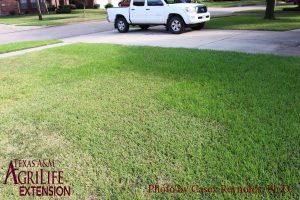
Tropical sod webworms feed primarily on leaves and rarely result in total loss of the turfgrass area. Perennial warm-season turfgrasses such as bermudagrass and St. Augustinegrass usually recover from this injury and the damage is typically superficial and temporary. However, if injury occurs above a desired treatment threshold, then an application of insecticide may be warranted to prevent further damage. Scouting for tropical sod webworm caterpillars can be done using a soapy water flush consisting of 1 tablespoon of lemon-scented liquid dish detergent

in one gallon of water. This mixture irritates the caterpillars (and other insects) and flushes them to the soil surface for counting and identification. If tropical sod webworms are present in turfgrasses in large numbers, it is important to treat as soon as possible to avoid further injury. There are many treatment options labeled for curative control of the larval stage of the tropical sod webworm, so please consult the Texas Turfgrass Pest Control Recommendations Guide for a complete list of products. As always, be sure to follow the product label for specific instructions on timing, use rate, and application methods.